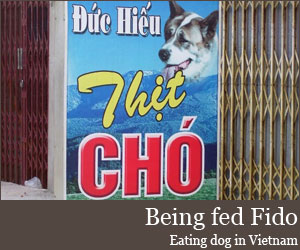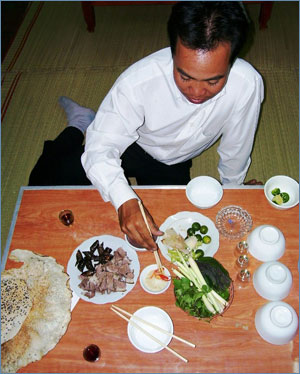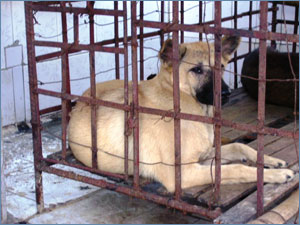Dogs and flower picture beautiful
Providing Dog Information, Pictures, Q & A and Reviews for all Dogs. Directory of Breeders and Shelters with Dogs and Puppies !
Search in this site
10/14/11
10/6/11
Being fed Fido: Eating dog in Vietnam
Being something of a culinary adventurer, I decided to try dog meat, and brought a Vietnamese guide along with me to share the experience. Afterall, eating dog is so much friendlier with two. Approaching the restaurant, I was in for a bit of a shock: a sign outside advertising Thit Cho, with a blown-up photo of a healthy-looking German shepherd prominently displayed. As if this were somehow appetizing. But then, when you think about it -- back in the US, a jolly cartoon pig on a sign outside a pork barbecue is not unheard-of. This was the same thing, right?
When I entered the courtyard of the restaurant, another shock: a dog happily bopping around among the low tables. Did the dinner get loose? No -- this was the family's pet dog. Okay.
I sat down, cross-legged at one of the tables and glanced to my left where I noticed two live dogs sitting glumly, silently, in a wooden cage. I definitely wasn't expecting to see that. At first I had a thought, rooted in denial, that these could be more pet dogs, that were just sitting in a cage ... for some reason.
But no. They were dinner.



I struggle with myself. Dogs are intelligent and affectionate. That's why we don't eat them. But then, pigs can be intelligent and affectionate as well. People keep pigs as pets. Pot bellied pigs. Vietnamese Pot Bellied pigs make excellent pets, and I eat pork all the time without thinking twice about it. I'm just being an ethnocentric western hypocrite.
I try to put the dogs in the cages out of my mind and get down to the business at hand -- devouring their fallen comrade. Dogs are eaten all over Asia -- Korea, China, Laos parts of Northern Thailand. I'm not going to impose my occidental world-view on what I'm experiencing. If it's a common practice among so many people, there must be something to it.
My 'guide' and I order up a dog feast. Roast dog, barbecued dog, dog stew. Just to cover all the bases. The locals at the other tables watch me out of the side of their eye, punctuated by nudges and chuckles to their friends, trying to gage if I like it. I dig into each offering as it arrives, and assure my Vietnamese audience that I enjoy it thoroughly. Even though that's not entirely true.
It's a strange taste. Not a bad taste. It's hard to explain. People who try lamb for the first time probably have a similar experience. Dog tastes nothing like lamb -- it's just a little different in sort of the same way. And despite numerous jokes to the contrary, it tastes nothing like chicken.
The barbecued dog is the best of the dishes. Cooked up on a charcoal grill, crispy chunks of meat in a sesame-seed marinade -- hard to go wrong with that. The roast dog presents much like roast pork, and has the mildest flavour. It's traditionally eaten with mam tam, which is a singular experience in itself. It's made from raw shrimp paste, and it smells and tastes exactly like raw sewage. I dip each piece of meat in it, if only a little, and struggle to get the point.
The most problematic entree in the dog feast is the dog stew. In an attractive clay pot, simmered in rice-wine, it's exactly like a succulent beef stew that I might otherwise be delighted to enjoy. But it's like eating insect flavoured ice cream. It's hard to enjoy it, even if it tastes good.
I ask my guide where they get the dogs we're eating. "From families with farms," he tells me.
Really? Farms? What kind of farms? Dog farms? The mind races.
No, not really 'dog farms.' Just regular farms, and along with the pigs and chickens, they raise some dogs sometimes, to be sold to dog restaurants.
In for a penny, in for a pound, I ask the question that is always on everyone's mind in relation to eating dog. "If someone's pet dog gets loose, could someone round it up and sell it to a dog restaurant?" After all, that's what we westerners are afraid of. Rover's on the barbecue. That's what makes it seem wrong.
My guide smiles. "We don't kill the dog if we love the dog," he assures me. "If we love the dog, we wait until it dies. Then we sell it to a dog restaurant."
Ah! That makes sense. Rover croaks, and, rather than letting him push up daisies in the backyard, you make 20 bucks off the traumatic event.
Let the healing begin.
I drink some more rice wine, a traditional accompaniment to dog meat in Vietnam. It tastes like lighter fluid, and kicks a punch of about 80 proof. Good thing in this case. It dulls my senses so I can get through the rest of the meal.
As we're leaving the restaurant I notice a place next door advertising meo. The sign out front features a picture of a cat. Something tells me it's not a pet shop. Despite my unnerving foray into dog consumption, I'm curious to give it a try. I'm not much of a cat person anyway. Probably tastes like chicken.
Vietnam people love to eat cat and dog
Dog eating is dying out in many other Asian countries: e.g. Taiwan, which today has very stringent laws against it and has just raised the fine levied on anyone charged with it. Hong Kong and Singapore (previously both were British colonies) outlawed it in the 1950's - but, in Hong Kong it was still going on in the rural areas in the 80's and early 90's - today it is virtually non-existent, and most Hong Kong Chinese are disgusted by it.
Korea is still a big problem, but there are wonderful local groups speaking out on behalf of the dogs.
Vietnam is a major dog-eating place, though traditionally (for what it’s worth) they do not torture the dog to death.
In addition, the Philippines has outlawed dog eating except for some tribal holidays - yes, it still goes on.....but its moving in the right direction.....I also would like to say that the push to stop dog eating in these Asian countries is driven by Asians, who feel exactly the same way about it as we do!
However, it's obviously something that is growing in China, it's very hard to know the exact number of dogs eaten, but it definitely must be in the many millions a year - maybe more. Still small if you consider that it is estimated that 556 million pigs are slaughtered every year in China.
The truth is many people in Vietnam eat dogs and cats and many people enjoy this food. Why do people choose to insult them? Many people in other countries, eat cows, pigs and chickens...... This is a fact.
Now there is huge issues relating to cruel treatment of livestock in some countries. Vietnam still has much to do in this area, and not just for the animals. If people learn more about the care of animals, improving their health, and living conditions. They will in turn generate more income from livestock and be able to invest in things such as the health and education of their own families.
Thousands of dogs saved from dinner table by Thai authorities
Thousands of dogs have been rescued after they were found stuffed into tiny cages destined for dinner tables across Vietnam. Thai police intercepted four trucks stacked high with crates packed with the animals in an operation in northeastern Thailand near the border with Laos.
A Nakhon Phanom livestock development official said 1,011 dogs were being held in a government shelter after two separate raids in Nathom and Si Songkhram districts. But she said a further 119 had died from either suffocation in the cramped cages or when they were thrown from the back of the trucks as the alleged traffickers tried to flee police.
Police officer Captain Prawat Pholsuwan said two Thai men and a Vietnamese man were charged with trafficking and the illegal transportation of animals. He said the dogs were being smuggled out of the country to be cooked and eaten in Vietnam.
"The maximum punishment is a one-year jail term and a fine of up to 20,000 baht (£410)," he said. Traffickers, who round up stray dogs and barter for pets in rural Thai villages, can receive up to £20 per dog in Vietnam, police said.
Korea is still a big problem, but there are wonderful local groups speaking out on behalf of the dogs.
Vietnam is a major dog-eating place, though traditionally (for what it’s worth) they do not torture the dog to death.
In addition, the Philippines has outlawed dog eating except for some tribal holidays - yes, it still goes on.....but its moving in the right direction.....I also would like to say that the push to stop dog eating in these Asian countries is driven by Asians, who feel exactly the same way about it as we do!
However, it's obviously something that is growing in China, it's very hard to know the exact number of dogs eaten, but it definitely must be in the many millions a year - maybe more. Still small if you consider that it is estimated that 556 million pigs are slaughtered every year in China.
The truth is many people in Vietnam eat dogs and cats and many people enjoy this food. Why do people choose to insult them? Many people in other countries, eat cows, pigs and chickens...... This is a fact.
Now there is huge issues relating to cruel treatment of livestock in some countries. Vietnam still has much to do in this area, and not just for the animals. If people learn more about the care of animals, improving their health, and living conditions. They will in turn generate more income from livestock and be able to invest in things such as the health and education of their own families.
Thousands of dogs saved from dinner table by Thai authorities
Thousands of dogs have been rescued after they were found stuffed into tiny cages destined for dinner tables across Vietnam. Thai police intercepted four trucks stacked high with crates packed with the animals in an operation in northeastern Thailand near the border with Laos.
A Nakhon Phanom livestock development official said 1,011 dogs were being held in a government shelter after two separate raids in Nathom and Si Songkhram districts. But she said a further 119 had died from either suffocation in the cramped cages or when they were thrown from the back of the trucks as the alleged traffickers tried to flee police.
Police officer Captain Prawat Pholsuwan said two Thai men and a Vietnamese man were charged with trafficking and the illegal transportation of animals. He said the dogs were being smuggled out of the country to be cooked and eaten in Vietnam.
"The maximum punishment is a one-year jail term and a fine of up to 20,000 baht (£410)," he said. Traffickers, who round up stray dogs and barter for pets in rural Thai villages, can receive up to £20 per dog in Vietnam, police said.
Chow Chow dogs
Fast Facts
Group classification: Non-Sporting Country of origin: China Date of origin: Antiquity
Weight (M): 50 - 70 lb Height (M): 18 - 20" Life expectancy: 8 - 12 years
Weight (F): 45 - 65 lb Height (F): 17 - 19"
1.General Description of the Chow Chow
The Chow Chow is a firm, powerful, squarely-built dog of medium size. Heavy bones and solid muscles endow the breed with its characteristic working appearance. The Chow Chow can have black, cinnamon, red, blue and cream coloring, and its appearance reflects northern roots and capability of enduring extremely cold temperatures. The breed’s wide-set, triangular ears are carried erectly with a slight forward incline and rest on a short, small and flat skull. The Chow Chow’s medium-sized, deep set, dark brown eyes are well separated and have an almond shape. It is possible for the breed to have two different coat-types; smooth or coarse, both of which are double-layered. The coarse-coated Chow Chow has a wooly, dense undercoat and a straight, extended outer-coat that forms a teeming ruff encircling the head and neck. The smooth-coated Chow Chow lacks the off-standing outer-coat but is otherwise identical. The tongue is blue-black and the inside of the mouth is black.
2.Chow Chow Temperament
The Chow Chow is an independent, dignified and intelligent breed—characteristics some say cause the breed to come across as detached, or cold. The breed is notoriously reserved and cautious in the presence of strangers but is not aggressive toward people. Although most Chows will work hard to dominate other dogs, the breed is usually quite good with children. The Chow’s compatibility with other pets depends on its exposure and socialization early in life, but is usually not good. Because of the breed’s determined and often over protective personality, it is crucial that obedience training begin at a young age to assure a well-adjusted adult dog.
3.Caring for a Chow Chow
The Chow Chow is a heavy shedder that, regardless of coat type, will require extensive grooming and needs to be shampooed on a regular basis. Owners should use a steel-toothed comb and devote special attention to the areas behind the ears and beneath the legs, as knots can form quite quickly in these regions. The Chow Chow has the potential to do well in an apartment, but it should receive adequate exercise in order to prevent excess weight gain. A daily walk will likely suffice. It is vital for owners to remember that the Chow Chow originated under very cold conditions and watch carefully for signs of over-heating, particularly in humid environments. Major health concerns for the Chow Chow include canine hip and elbow dysplasia, patellar luxation and entropion. Other concerns include distichiasis, cataracts, persistent papillary membrane, elongated palate, glaucoma, gastric torsion and stenotic nares.




















































